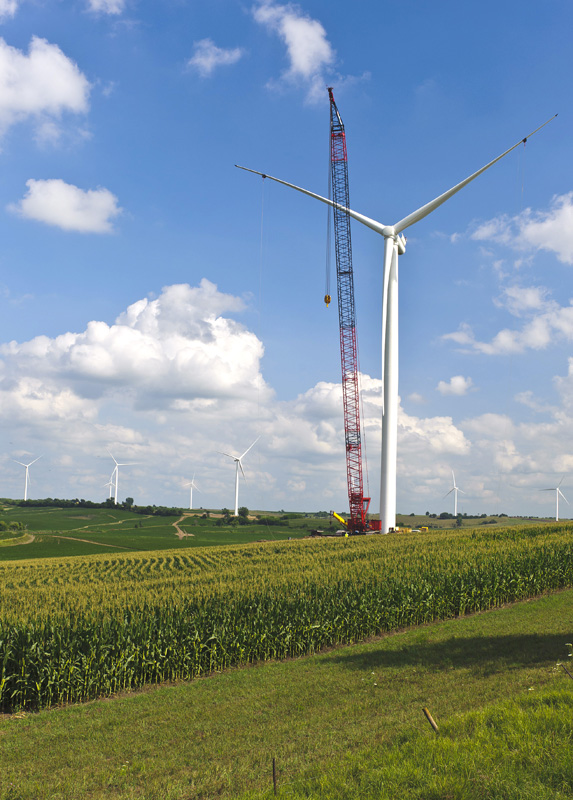Rolling Hills adds
whopping amount of wind power
The
completion of the Rolling Hills wind project in Iowa marks a
significant milestone for Mortenson Construction, with Rolling Hills
being its 100th wind power project. Rolling Hills also added a whopping
443.9 MW of wind power to MidAmerican Energy's renewable portfolio.
By
Diane Mettler
The Rolling Hills wind project in Iowa was significant for a number of
reasons.
In addition to it being Mortenson Construction's 100th wind project,
Rolling Hills is also the largest single-phase wind project the company
has constructed—ever.
In 1995, Mortenson installed its first wind project in Adair, Iowa.
Little did the company know then that several years later, it would
install a project more than twice that size, just down the road.
Tim Maag, vice president and general manager of Mortenson's U.S. wind
business, says the massive 193 turbine, 443.9-megawatt Rolling Hills
wind project has been a success on many levels. Not only is it a great
accomplishment for the company, but it also created jobs and generated
revenue for the local community.
Mortenson was selected by major utility MidAmerican Energy Company
through a competitive tender process to construct the wind project and
to install access roads, underground electrical collection systems, and
internal tower wiring. The company immediately got busy completing
engineering work and procuring materials.
By the end of April 2011, Mortenson was setting up on the site and
installing work trailers and the construction lay-down area. By
mid-May, construction began in earnest. In three months, the wind farm
was beginning to produce energy, and by the end of 2011, Rolling Hills
was fully commissioned and on-line.
To get a wind farm of this size completed and operating in less than a
year speaks to the strong relationship between MidAmerican Energy and
Mortenson, as well as Mortenson's relationships with manufacturers and
contractors.
"We've built 17 projects in Iowa," says Maag. "And Rolling Hills was
the sixth project we've built for Mid-American Energy, so there was
really no learning curve in terms of working with MidAmerican."
| |
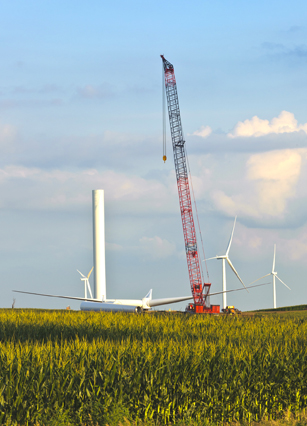 |
| |
True to its name, the terrain
on the Rolling Hills project is very hilly, so it required a lot of
breaking down cranes to get from one site to the next. All of the
foundations had to be buoyant to withstand a very wet environment.
|
|
|
The choice of Siemens turbines, Maag says, was in part due to the fact
that certain components were manufactured in Iowa. The enormous
blades—half the length of a football field and 12 tons
each—were manufactured at Siemens' blade manufacturing plant
in Fort Madison, Iowa.
A total of 193 Siemens 2.3 MW wind turbines were used on the Rolling
Hills project. Coincidentally, Siemens had supplied 76 of its 2.3 MW
wind turbines for the Adair wind project, down the road.
So Mortenson was more than familiar with Siemens turbines. In fact,
including Rolling Hills, they have installed approximately 340 Siemens
turbines to date with another 138 to be erected by spring for projects
currently under construction.
"Again, we have a great working relationship with Siemens," says Maag.
"Overall, it was an efficient process. The landowners also helped move
the project along. We had several meetings to keep them informed of the
construction progress, where our traffic would be routed, and how it
would be coordinated with their farming activities," says Maag.
"The individuals we dealt with were absolutely great—very
interested in the project and easy to work with."
There are always challenges with wind power projects, especially with a
project of this magnitude. One of the biggest obstacles was obvious
from the name—Rolling Hills.
"The terrain was very hilly, so it required a lot of breaking down
cranes to get from one site to the next," says Maag. "The wind was an
issue, which we battled pretty much all summer long.
"Also, all of the foundations were buoyant, meaning they were built to
withstand a very wet environment. The ground can be completely
saturated, and the foundations are large enough to handle it," explains
Maag.
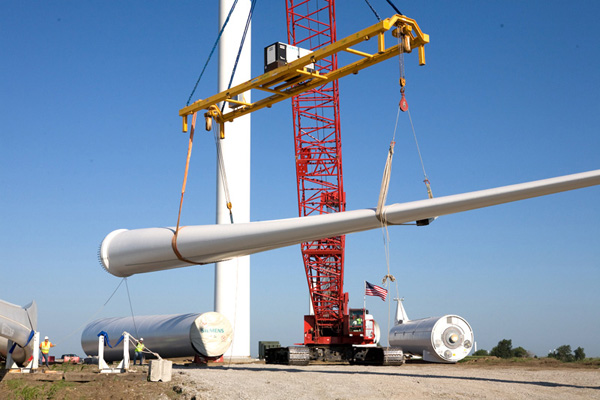 |
|
|
Mortenson Construction is very
familiar with Siemens turbines. Including Rolling Hills, they have
installed approximately 340 Siemens turbines, with another 138 to be
erected for projects currently under construction.
|
|
Each
foundation for the 80-meter tall turbines required 500 to 600 cubic
yards of concrete. When erection began in July, Mortenson averaged two
turbines per day, using Manitowoc cranes and several Grove
rough-terrain cranes.
"We were frequently shut down by the wind, so when the winds were down,
we worked very long days, sometimes erecting three or four wind
turbines in a day and other days as little as one or two because we had
to move the crane," says Maag.
At the peak of construction, there were more than 300 employees on
site.
"We had around 150 Mortenson employees, and the rest were subcontracted
employees. Most of the workers were union and locals living within a
90-mile radius of the project site."
The crew had its work cut out for them. In addition to erecting the 193
turbines, Mortenson constructed 37 miles of access roads and 139 miles
of underground electrical collection cable at the Rolling Hills wind
project.
"While we performed nearly 50 percent of the labor with our own
craftworkers, subcontractors, such as Rachael Contracting out of
Minneapolis, also provided craftworkers to help build access roads,"
says Maag. "We also hired JF Edwards Construction as the electrical
collection subcontractor and Century Engineering to do the tower
wiring."
The Rolling Hills wind project was designed and built for MidAmerican
Energy. MidAmerican Energy isn't just a big player in the energy
industry; it's Iowa's largest energy company, providing electrical
service to 729,000 customers and natural gas service to 709,000
customers in Iowa, Illinois, Nebraska, and South Dakota.
MidAmerican Energy ranks as the No. 1 rate-regulated utility in the
U.S. in terms of ownership of wind-powered capacity. In 2011, the
443.9-megawatt Rolling Hills project, located in Adair, Adams, and Cass
counties, was one of three MidAmerican Energy wind projects constructed
in Iowa. An additional 13 wind turbines were constructed in Pocahontas
and Calhoun counties, and 52 wind turbines were constructed in Marshall
County—all by Mortenson. Once completed, the 258-wind-turbine
expansion project added 593.4 megawatts of renewable energy to
MidAmerican Energy's generation portfolio, enough capacity to power
approximately 190,000 average U.S. homes.
All this activity had a positive impact on small communities, such as
Massena, Iowa. Massena is located in the heart of the Rolling Hills
wind project.
| |
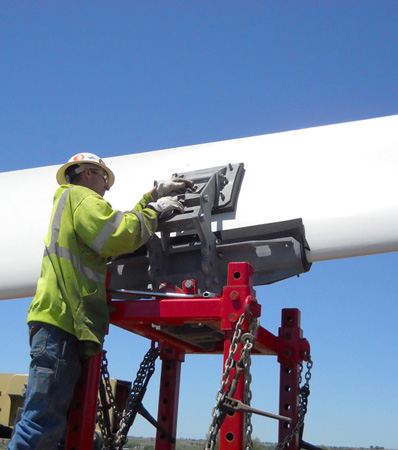 |
| |
The choice of Siemens turbines
on the Rolling Hills project was in part due to the fact that certain
components were manufactured in Iowa. The enormous blades—half
the length of a football field and 12 tons each—were manufactured
at Siemens' blade manufacturing plant in Fort Madison, Iowa.
|
|
Not
only did construction crews fill the local restaurants, Mortenson also
used local suppliers to purchase a variety of supplies.
"We also used a lot of the same equipment the local farmers do, and we
used local mechanics to fix tires and help keep our equipment running,"
Maag explains. "It was a huge boost to the local economy, not to
mention the fact that the turbines are going to be there for many years
to come."
It's not all about economic benefit though. Mortenson gave back to the
community in other ways.
"One of the things we do is partner with the local fire department in
the area. Together, we do tower rescue training to make sure they are
prepared for an emergency. We also presented our Catch the Wind program
to local schools, which is designed to help educate children about
renewable energy," explains Maag.
Rolling Hills significantly added to Iowa's already robust wind energy
portfolio. As of the end of 2011, Iowa had 4,322 MW of wind power,
ranking it #2 in the U.S., after only Texas.
With the completion of the project and several new projects underway,
Maag is looking ahead to the future of the wind industry and is
encouraged by the advances he is seeing in technology.
"It's amazing that a 2-megawatt turbine can provide power for 400 to
600 homes. Now there are turbines as large as 3 megawatts and growing.
It's truly impressive how much energy a single turbine can produce now
because of the technology, even with low wind environments.
Undoubtedly, wind power will continue to be a significant part of the
U.S. energy market in the years ahead."
Fifteen years from now, Maag believes wind turbines will be generating
an enormous amount of power. He can easily see a single turbine in the
future replacing two or three of the turbines installed today.
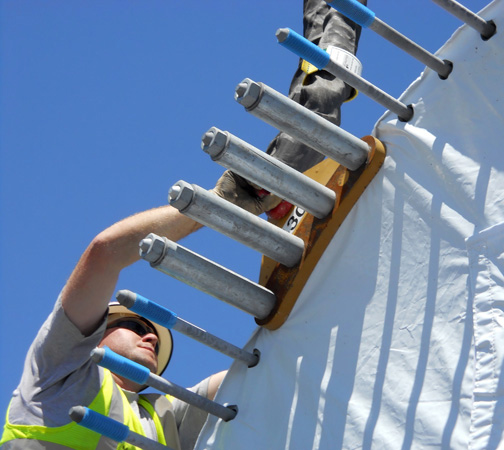 |
|
In fact, Mortenson already is replacing turbines installed years ago.
"When we work on the west coast, we are doing some repowering of
projects where we'll take down existing turbines and replace them with
newer, more powerful turbines. We're starting to do some of that for
projects that are 15 to 20-plus years old in California," says Maag.
With a project the size of Rolling Hills under their belt and with more
than 100 wind projects now completed, it's hard not to feel some pride
in a well-run company.
Mortenson, a family owned business, is the 19th largest construction
company in the U.S., with revenues of approximately $2.5 billion.
According to Engineering News Record (ENR), Mortenson is ranked as the
second largest wind contractor in the U.S.
"ENR recognizes Mortenson as the only power contractor that dedicates
100 percent of its power industry to the renewables business," says
Maag. "When you see others that are ranked in the power industry, they
might do fossil, they might do nuclear, they might do various types of
energy. We focus solely on renewables—primarily wind and solar,
with some geothermal and hydroelectric.
"We welcome the opportunity for more projects in the future," says Maag.
March/April
2012
|





|




